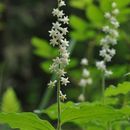mk
имиња во трошки


Flowering from May to June; fruiting from August to October.
Maianthemum henryi is close relative of Maianthemum szechuanicum, but differs from the latter in its perianth tube 6-10 mm long, nearly as long as perianth (vs. 3-4 mm, half as long as perianth).
Maianthemum henryi is occurring in Gansu, Henan, Hubei, Hunan, Shaanxi, Shanxi, Sichuan, Xizang, Yunnan of China, N Myanmar, Vietnam.
Phylogeny of Maianthemum (Ruscaceae) was inferred from eight chloroplast and nuclear markers (trnL-F, rps16, rpl16, psbA-trnH, rbcL, ndhF, trnK, and ITS) (Meng et al., 2008). Phylogenetic analyses supported the monophyly of Maianthemum with Maianthemum sensu stricto nested within Smilacina. Almost all species from the eastern Himalayan region in SW China except for Maianthemum tatsienense and M. stenolobum form a well supported clade. This clade is characterized morphologically by short filaments and large anthers, relatively large flowers, and pubescent stems and leaves. The intercontinental disjunction between eastern Asia and North America in Maianthemum sensu stricto is estimated to be at 1.68 million years ago (mya) with the Bayesian relaxed clock relying on uncorrelated rates. A recent radiation at about 2.04 mya is suggested in the high mountains of SW China, corresponding to the geographical heterogeneity in that region after the uplift of the Himalayas. Long distance dispersal by birds may have facilitated the evolution of their intercontinental disjunction and their biogeographic diversifications in SW China.
Plants 45-85 cm tall. Rhizome submoniliform, ca. 1-2 cm thick. Stem hispidulous or hirsutulous distally, rarely glabrescent. Leaves 5-8, subsessile or shortly petiolate; leaf blade elliptic, ovate, or oblong, 10-25 cm long, 4-12 cm wide, pubescent or glabrescent. Inflorescence a raceme, sometimes a panicle, 5-17 cm long; rachis pubescent. Flowers solitary; pedicel pubescent. Perianth yellowish green to white, funnelform; segments connate except distally, forming a long tube, tube 6-10 mm long, lobes spreading. Stamens short. Style slightly longer than ovary; stigma 3-lobed. Berries red at maturity, 2-4-seeded.
The chromosomal number of Maianthemum henryi is 2n = 36 (Wang et al., 1993).
Growing in forests, thickets; 1500-4000 m.
Maianthemum henryi là một loài thực vật có hoa trong họ Măng tây. Loài này được (Baker) LaFrankie mô tả khoa học đầu tiên năm 1986.[1]
Maianthemum henryi là một loài thực vật có hoa trong họ Măng tây. Loài này được (Baker) LaFrankie mô tả khoa học đầu tiên năm 1986.